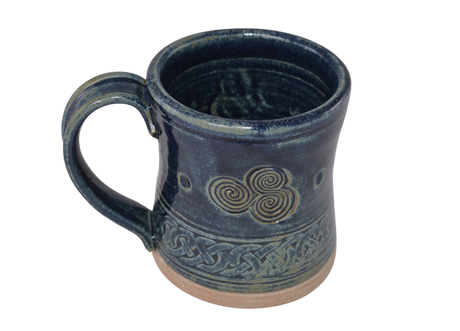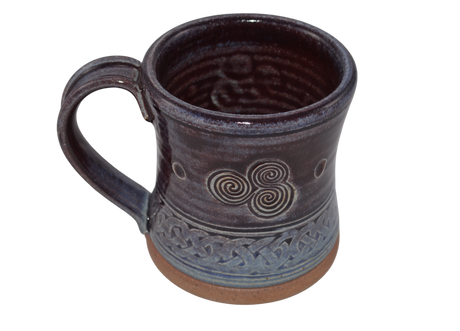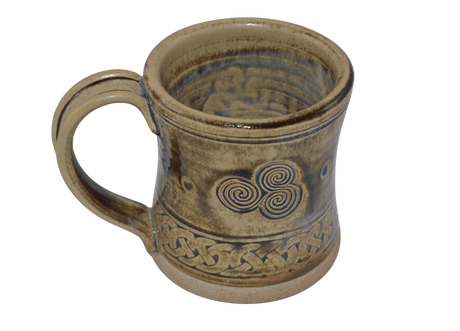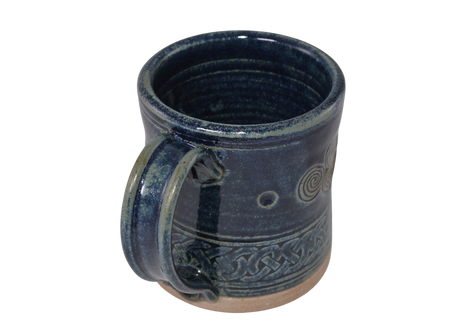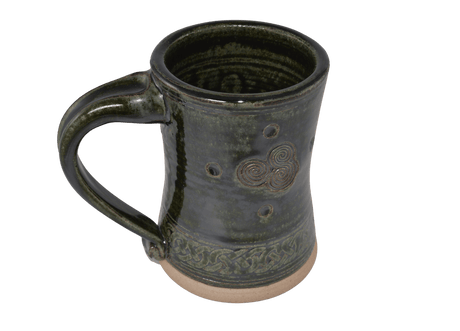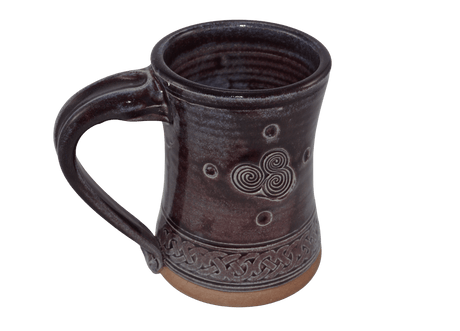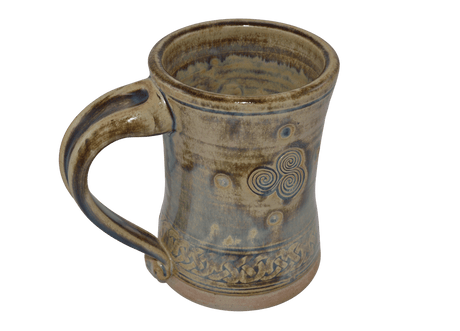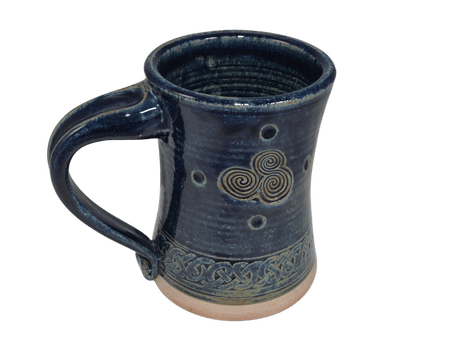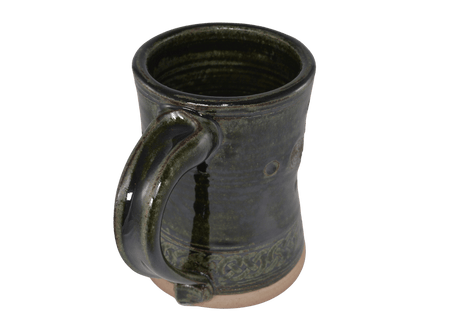Ciaran O'Conboirne brings Ireland's ancient artistic traditions to life through his handcrafted pottery under the name of Celtic Clays. Based in Omeath, County Louth, Ciaran has made the journey from a teenager fascinated by Celtic designs to a master potter over more than three decades.
His work features intricate Celtic and pagan patterns embossed on functional and decorative pieces, with glazes inspired by the colors of the nearby Cooley mountains.
In this interview, Ciaran shares the origins of Celtic Clays, his unique approach to pottery-making, and his philosophy on art and life. From building his own kilns to developing custom clay and glaze recipes, we’re sure you’ll agree that Ciaran's hands-on approach and dedication to his craft shine through in every aspect of his work.

Pictured above: Stuart Marley & Ciaran O'Conboirne
Real Irish:
Hi Ciarán! We’ve always loved your pottery here at Real Irish, and we’d love to hear more about the origin story! Where did you first discover Celtic design?
Ciaran O'Conboirne:
I was interested in Celtic design long before I ever was interested in pottery. My inspiration came when I was about 15 when my ma bought me a book by Jim FitzPatrick, the Legends of Ireland, about the Táin Bó Cúailnge and the origins of all the different tribes and invasions.
Along with the great story were the illustrations Jim did in the books, and I remember thinking to myself, even way back then, 'What a legend of a man!'
Things like that were never taught in school. We're living in Ireland — but the reality is that very few people in Ireland know how to do Celtic design! I was fascinated by the patterns and the complexity of it. So I bought a couple more books, learned about the mathematical formula behind it, and I started doodling and learned how to construct different things.
Later on I went to art college in Belfast. Let's say that the college was not very conducive towards my own culture! But you can't kill a good thing! So I was always going to go back and learn more about Celtic art. After college I did an apprenticeship on the west coast of Ireland with the potter Michael Kennedy, one of the best throwers in Ireland. I watched the man work and I was in awe. Michael's style was different to mine, but I learned a lot from him.
After that, I met an American woman and ended up in America for a few years. I got a job at a university teaching ceramics. I put together the beginnings of Celtic Clays there. And that was the beginning of Celtic Clays. It started in America!
Real Irish:
Amazing! But you’re back in Ireland now, in Omeath in County Louth, beside the Irish Sea. How did you make it back?
Ciaran O'Conboirne:
Well my then girlfriend — now my wife! — decided we were going back to Ireland! I had saved up about five grand. I went back home to County Down and my dad had an old garage. He said, “Well, knock yourself out.” I spent all the money I'd saved up and bought a pile of bricks, a wheel, some glaze materials, and a ton of clay. The rest was blood, sweat, and tears.
I had to go the whole hog and design and build my own kiln. I'm now on kiln number five, and I've got it nailed now!
Real Irish:
Wow. So we’re guessing that as you’ve been in business for a few years now, you could have bought your own kiln later on. Why do you still build your own?
Ciaran O'Conboirne:
Because I can build them better than the people that make them now! When you know the physics of it and how they work, I can build it to do exactly what I want it to do. Every kiln will have its own nuances of how it should be fired. It isn't just a pile of bricks. It's where you place the burners and the convection heat flow through the kiln, how big your chimney is, all sorts of things like that.
I've got a pretty kick-ass trolley kiln now, which means I can pull it out. It's on wheels. The chamber actually comes right out of the kiln and I can stack up the pots and push it back in. That allows me to not have to cripple my back while I'm packing the thing!

Celtic Clays pottery in progress
Real Irish:
You mentioned that there was nobody teaching Celtic design when you were in college. What is Celtic design? In your eyes, how would you define it?
Ciaran O'Conboirne:
Celtic design is something that a lot of people would say has no beginning and no end — like a continuous knotwork pattern, or a spiral pattern where the spirals all interlink continuously.
But there is a differentiation. Spirals actually were not Celtic. Spirals started 5,000 years ago in the megalithic period. You see them in Newgrange, in the tomb, and on the west coast of Ireland. They then became adopted into Celtic design when the Celts arrived around 600 BC. Christianity came later, and had the Book of Kells and the Book of Durrow, and they adopted all of those intricacies and patterns.
Celtic design might look complex, but it’s fascinating. It keeps the eye moving. You're always wanting to trace your finger along, like a child doing a maze puzzle.
But when I work on my designs, I know I can't repeat and do things that were constantly done in the past. You have to add something of yourself to it. So I’ve added human forms, birds and animals to my own designs, which in Celtic design would have been called zoomorphics. I prefer to make it look more realistic and add Celtic design to the realism.
Real Irish:
Your products are really phenomenal. Tell us a little bit about what you produce.
Ciaran O'Conboirne:
I do everything from mugs, bowls, platters, goblets, beer steins, whiskey tumblers, butter dishes, casserole dishes — anything you would use at a table setting. Plus I also do vases and large jugs that would be more ornamental.
And then the artwork — I've taken iconic symbols like the Brown Bull of Cooley. I drew a bull and the Slieve Foy Mountain and incorporated Celtic design into that artwork, had it printed on thick German printing paper and framed by a local framer. So I do the Brown Bull of Cooley, the Children of Lir, my version of the Celtic Tree of Life, and a Celtic cross, which is a mix of a German cross with the Celtic sun in the background.
The Hounds of Cúchulainn too. If you open up any book, say the Book of Kells, you’ll see three dogs chasing around in a circle. So I just personalized the dogs a bit myself. The symbolism of the Hounds of Cúchulainn is strong. Cúchulainn is huge in this part of the world. The dog is like the guardian of the house. A lot of people have wood carvings of Celtic dog stuff stuck above their back door as a guard symbol.
I try to combine spirals and Celtic knots in every piece. Usually, you'll see a mixture of the two.
Real Irish:
How do you think about the materials and clay that you use?
Ciaran O'Conboirne:
All clay that potters in Ireland use is manufactured. It's very rare that you get somebody that digs it out of the ground. You can't do that in production pottery because you'd have to sieve it to get rid of the stones and grit, and for throwing pots, the clay needs to be stretchy.
I buy my clay from a guy in Banbridge. Years ago, I told him what I was looking for: clay that's stretchy, has a bit of iron in it so that it reacts with the atmosphere in the kiln, and other specifications. He got to work on it, and after about three attempts, he nailed it.
The glaze materials are raw elements like flint, feldspar, and China clay. These are all in powder form. It's like making a cake — you've got different ingredients. Then you've got your oxides, which give you the colors. These are my recipes that I've developed over the years.
Real Irish:
When people buy, do you think they’re buying the story behind the product as as much as the product itself?
Ciaran O'Conboirne:
I think personality and what I do have something to do with it, but there's also the fact that it is handmade in Ireland. I developed those glazes based on the scenery around here. If you walked around here and looked at my green glaze, then looked up at the top of the mountain and saw the dark trees, that's where that green comes from. It's really, really dark.
If people come in here and I start explaining about the colors, they know it's not some made-up story. It's actually real.
Real Irish:
Do you have a shop or studio people can come into? Where else do you sell? Have some of your pieces ended up far-flung around the world?
Ciaran O'Conboirne:
I have a small shop right next to the studio. It's about a five-minute walk from the village of Omeath. And my pieces — honest to God, they're everywhere now! In South America, South Africa, Australia. There were even a couple of Chinese people in, and somewhere in China now there are two people drinking their tea out of Celtic Clay mugs!
Real Irish:
How about the future for you and Celtic Clays? Any big plans or ambitions?
Ciaran O'Conboirne:
There's a book called The Lorax, by Dr Seuss, and it should be how everybody lives. It talks about the "bigger, bigger, more, more" capitalism mentality. In the end, it all goes wrong and the environment is destroyed. There's a lesson there — you can be content with less instead of always wanting more, and you don't have to harm anything to get what you want.
I'm older now. I've seen plenty, and I'm happy with where I'm at. I live in a lovely spot, I get to go swimming in the sea, go walking with my dogs, and drink a pint of Guinness the odd evening. What the hell more would you want?!


